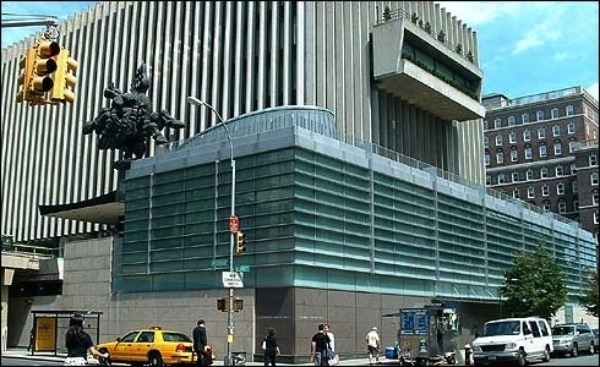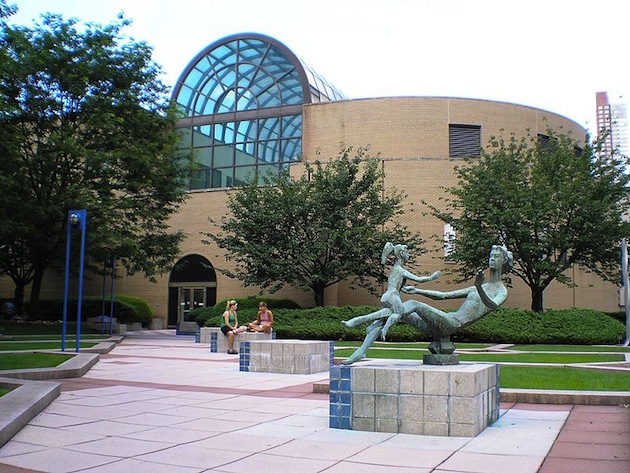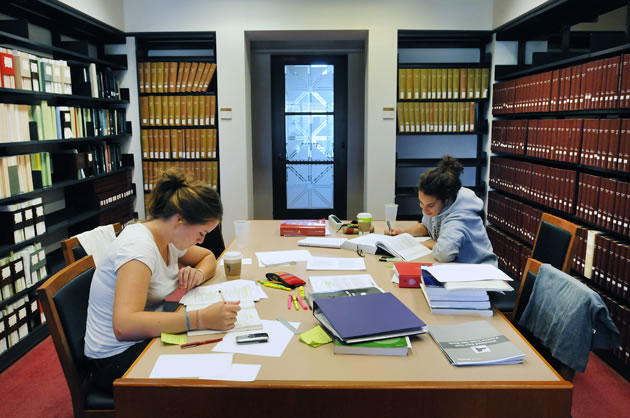
Columbia Law School in New York City
COLUMBIA LAW AMONG THE BIG WINNERS
Overall, there were just three changes in the Top 10. The biggest one, however, was Columbia Law moving up to a tie with Chicago Law for #4. The reason? Columbia Law crept up in all the key measures. Notably, the school lowered its Acceptance Rate from 17% to 16, while boosting its 10-month Placement (95.1% vs. 93.3%) and bar passage rates (98.1% vs. 97.7%) in its New York jurisdiction.
Northwestern Law and U.C.-Berkeley Law also each climbed a spot to #9. The former followed the same route as Columbia law, lowering its Acceptance Rate by a point while increasing its Placement and Bar Passage Rate. The school’s median Undergraduate GPA and LSAT scores inched up as well. Despite a lower Bar Passage rate, Berkeley Law produced a higher Peer Assessment score and Undergraduate GPA average – measures that account for 35% of their ranking weight.
Of course, these schools’ surges came at the expense of Duke Law, which slipped two spots to #12. While Duke Law improved several inputs such as Acceptance Rate, it reported lower Placement (92.7% vs. 95.6%) and (to a lesser extent) Bar Passage (95.6% vs. 97.8%). USC Law and Washington University Law flip-flopped the 17th and 18th spots respectively, while Boston University Law debuted in the Top 20 at #20 (of course).

Fordham University School of Law
70% OF TOP 50 SCHOOLS ARE TIED WITH ANOTHER PROGRAM
The school’s three-spot jump came courtesy of a near across-the-board improvement, including Judge and Lawyer Assessment Score (3.6 vs. 3.5), Median GPA (3.56-3.86 vs. 3.49-3.84), Placement (95.6% vs. 92.7%), and Bar Passage Rate (97.8% vs. 95.2%). Boston University Law even cut its Faculty-to-Student Ratio from 6.8-to-1 to 6.3-to-1. Boston University Law nudged Minnesota Law from 20th to 21st. The reason? The school’s improved Placement Rate and Peer Assessment couldn’t offset a lower Median GPA and Bar Passage Rate.
Among the Top 50, the biggest gain was made by Fordham Law, which vaulted from 39th to 27th, which was buoyed by an 11.1% improvement in 10-month Placement. The College of William & Mary and the University of Florida rose eight and seven spots respectively. In contrast, Wake Forest Law tumbled 11 spots as a result of lower median LSAT scores – and an 18.3% drop in Bar Passage. That said, Wake Forest Law wasn’t alone in losing ground. Among the Top 50, Arizona Law and Illinois Law both lost 8 spots, with North Carolina Law and U.C.-Davis Law falling 7 spots.
Such losses aren’t necessarily an indicator of lower performance. That’s because the U.S. News ranking is riddled with ties. Among the Top 50 programs, there are ten ties netting 35 schools – a sure-fire sign that the ranking methodology is ripe for reinvention. Notably, three schools are tied at 9th and 24th – and another four schools are each bunched up at the 27th, 38th, 42nd, and 47th marks. There are even six schools jammed together at 31st. While this may provide small comfort to law schools, it also indicates just how thin the margin for error is – and why schools look so closely at controllable measures like LSAT and GRE.

Georgetown Law
GEORGETOWN LAW RULES THE PART-TIME SPACE
Along with the full-time law schools, U.S. News also publishes a ranking of part-time programs based on a more streamlined methodology. 50% of the weight is taken up by a Quality Assessment, where deans and three faculty members from each school rated their peers on the same 1-5 scale as their full-time counterparts. Another 27.5% goes to Median LSAT, GRE, and Undergraduate GPA scores. The remainder is organized around nine factors, including section size, involvement of part-time students in law clinics and law journals, simulation courses, field placements, and performance in interschool skills competitions.
Sure enough, Georgetown Law repeated as the top program, notching the highest Peer Assessment score, median LSAT score, and lowest Acceptance Rate. Overall, 9 of last year’s Top 10 returned to the Part-Time ranking, with Georgia State replacing the University of Houston. Fordham Law and George Washington Law exchanged the #2 and #3 spots respectively, as did George Mason Law and Maryland Law with the 4th and 5th spots. Factor in American University and five-of-the-six highest-ranked part-time law programs are located in the Maryland-DC-Virginia corridor.
U.S. News also ranks law schools by specialty, with scores excluded from the overall ranking. Overall, U.S. News evaluated 13 specialties, including four new categories: Business Corporate Law, Contracts and Commercial, Criminal Law, and Constitutional Law. The scores are based on surveys conducted with law faculty in each of those particular specialties, who score peer schools in their particular area of teaching. To be considered, a school must receive a score (same 5-point survey scale) from 10 or more respondents.
This year, there were three specializations with a change at the top. In Dispute Resolution, Harvard Law replaced Ohio State Law. Berkeley Law overtook Stanford Law for the top spot in Intellectual Property, while Lewis & Clark outpointed Pace University in Environmental Law. The remainder of the Specializations maintained the status quo: New York University Law ranked #1 again in Tax Law and International Law. Georgetown Law held sway with Clinical Training, no different than Saint Louis University (Healthcare), University of Nevada-Las Vegas (Legal Writing), and Stetson (Trial Advocacy).
Among the new specializations included, Columbia Law ranked #1 in both Business Corporate Law and Contracts and Commercial. Across town, New York University Law bested its peer schools in Criminal Law. Not surprisingly, Constitutional Law was the purview of Yale Law.
To see how the Top 50 law schools rank, go to the next pages.

Questions about this article? Email us or leave a comment below.